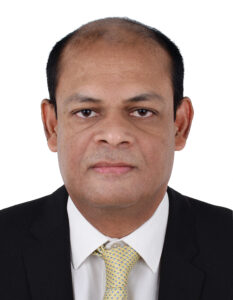Demand for greater efficiency and better IAQ are among factors behind a vibrant heat exchangers market in the GCC region, says Indu Revikumar, Features Writer, Climate Control Middle East
COVID-19 did not spare the heat exchangers market, either. Now that the raging has stopped and even the embers are burning dimly, the heat exchangers market is showing signs of recovery. And this resurgence can be attributed to the increasing demand for energy-efficient solutions and the adoption of renewable sources of energy in the heating and cooling sector. A report published by Strategic Market Research, in April 2023, indicates that the global heat exchangers market is projected to exhibit a robust Compound Annual Growth Rate (CAGR) of 5.3%. According to the report, the market was valued at USD 16.01 billion in 2021, which increased to USD 16.86 billion in 2022. This positive trend is expected to continue, leading the market to reach an estimated value of USD 25.5 billion by 2030.
Joe Rappai, Head of Heat Exchangers (Middle East, Turkey and Africa), Danfoss, says it is hard to put a definite number to the size of the heat exchangers market in the GCC region, though, as there are different types of heat exchangers and several variables, namely investments and regulations. However, he adds, the demand for plate heat exchangers has been growing, particularly in Saudi Arabia, in line with the giga-projects and mega-projects being rolled out as part of Saudi Vision 2030 and Saudi Green initiatives. “The growth of plate heat exchangers markets in other countries in the GCC region can also be attributed to the various initiatives in relation to sustainability and Green Energy, namely UAE Vision 2030, Egypt Vision 2030, Qatar National Vision 2030, Bahrain Economic Vision 2030, Oman Vision 2040 and Kuwait Vision 2045,” Rappai says.
For his part, Matteo Zanesco – Group Head of Sales & Marketing – Heat Exchangers and Mechanics division, CAREL, says among several types of heat exchangers suitable for different applications being used in the HVAC market in the GCC region, air-to-air heat exchangers, namely, rotary wheel and crossflow heat exchangers, are becoming common for every HVAC unit design, to bring fresh air in the buildings. He adds that companies that manufacture these units in the UAE and Saudi Arabia, drive market sales in the GCC region. “Moreover, the importance of ensuring a better quality of air inside the buildings, one of the most discussed topics in the post-pandemic era, also contributes to the rise in demand for energy-efficient heat exchangers and accessories,” he says.
Zanesco highlights that there is a significant focus on improving Indoor Air Quality (IAQ) in buildings in the post-pandemic era. He says, “We have been dedicated to achieving maximum energy efficiency while enabling this objective to improve IAQ and actively expanding its market presence in heat exchangers and related accessories through mergers and acquisitions under the Recuperator and Klingenburg brands.
The shift in customer preference is not only in terms of type of heat exchangers but also capability or objective. Rappai says there has been a shift in customer preferences, as many prefer plate heat exchangers within the range of 60-80 bar operating pressure and temperatures starting from 350 degrees C to 400 degrees C, primarily due to their energy efficiency. Expanding on preferred choices in the heat exchangers market, Rappai says, “Energy efficiency is a great topic of concern among the industries, and the high demand for plate heat exchangers could be attributed to its high thermal efficiency.” He adds that plate heat exchangers are the most common type in HVAC and District Cooling applications and that several of the projects in the region are now going for AHRI-certified plate heat exchangers.
Adding to the discussion on market preference, Fred Penhall, Managing Director, CAREL ME, says, “While crossflow plate heat exchangers are more prevalent in specific applications, like hospitals, due to their ability to provide improved airflow separation, the rotary heat exchanger remains the most commonly used type of air-to-air heat exchanger.”

Joe Rappai
Additionally, Rappai says there is an increasing demand for advanced heat exchangers in retrofit projects that aim to attain energy efficiency and sustainability objectives. “In the GCC region,” he says, “retrofitting existing infrastructure is crucial to reduce energy consumption, and as a result, industries are now on the lookout to achieve operational excellence, to improve productivity and profitability.” He adds that heat exchangers could play a crucial role in retrofitting, as they offer a smaller carbon footprint, high thermal efficiency, corrosion resistance and reduced fouling.
Further, Rappai points out that manufacturers in the region are making substantial investments in research and development to enhance the efficiency of heat exchangers. Danfoss, he says, has introduced a thinner and more energy efficient ‘D-plate ’series, which is a simple, user-friendly solution with the potential to improve building performance and energy efficiency, which is particularly important for countries in the region that are focused on sustainability and energy efficiency goals.
Elaborating on the market demands, Rappai says, “COP27 and the upcoming COP28 serve as crucial factors in the GCC region’s orientation towards sustainable solutions and energy-efficient products.” He underlines that the region’s various green initiatives clearly indicate this shift and, therefore, companies are expected to offer solutions that align with the region’s decarbonisation goals. He says, “Though cost is a crucial factor, customers are leaning towards long-term energy-efficient and reliable solutions, making products that offer high energy efficiency and reliability more popular among consumers and businesses.”

Matteo Zanesco
Zanesco notes that while the cost of heat exchangers and overall solutions remains a primary consideration in decision-making processes, the weightage for energy-efficiency of the product has been increasing. “There is a shift towards evaluating operational costs, rather than solely focusing on initial investment costs, and this signifies a recognition that long-term operational efficiency and savings play a significant role in decision-making, alongside upfront expenses,” he says.
Weighing in on the discussion, Penhall says the efficiency of rotary and cross-counterflow plate heat exchangers can be enhanced by utilising new materials that enable heat transfer and humidity transfer. “New materials, which are suitable to transfer not only heat but also humidity, can outperform the standard aluminium material commonly used and offer improvements over the traditional shape of crossflow heat exchangers,” he says.

Fred Penhall
Efficiency is as much an outcome of proper maintenance as is proper selection of equipment. Touching on the maintenance issues concerning heat exchangers, Rappai says that implementing predictive maintenance and effectively using data allow manufacturers to easily predict and prevent potential issues and react on time seamlessly. He says, “Such maintenance strategies use sensor data to determine the condition of the equipment in service (condition-based maintenance) or predict future failures (predictive maintenance). He adds that a lot needs to be done to utilise data for condition-based maintenance and remote service equipment in a more effective manner. Meanwhile, Penhall says that even though maintenance is undoubtedly essential, the key to enhancing product lifespan and performance also lies in designing products that align with reliable working conditions.
Overall, the heat exchangers market is poised for growth, driven by increasing demand for energy-efficient and sustainable solutions, while the cost remains a consideration. In the GCC region, there is a rise in demand for plate heat exchangers among several types of heat exchangers available in the market, mainly due to the significant investments made in sustainability initiatives. Moreover, manufacturers in the GCC region are also investing in research and development to enhance the operational efficiency of heat exchangers and meet the demand for advanced heat exchangers.
Copyright © 2006-2025 - CPI Industry. All rights reserved.